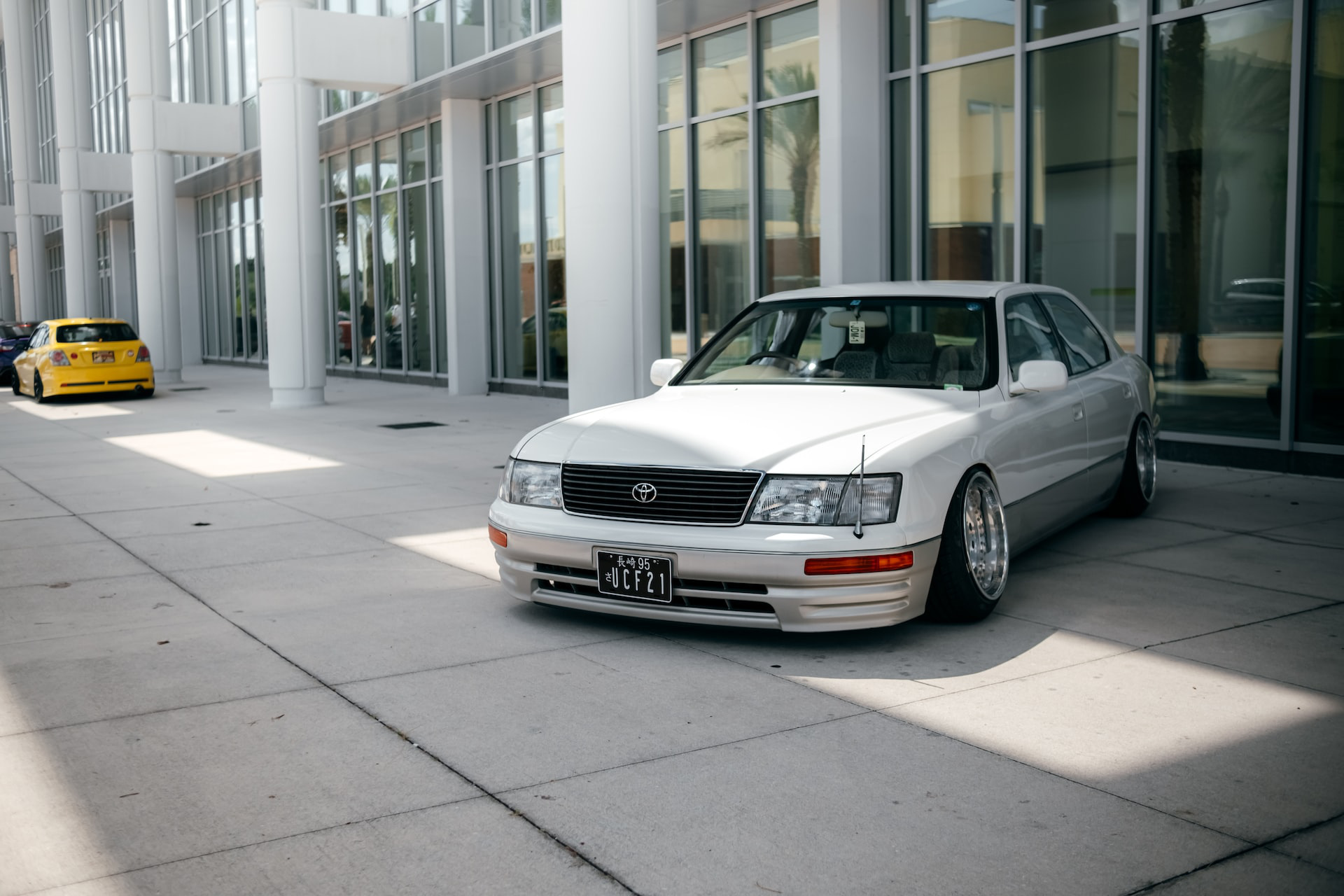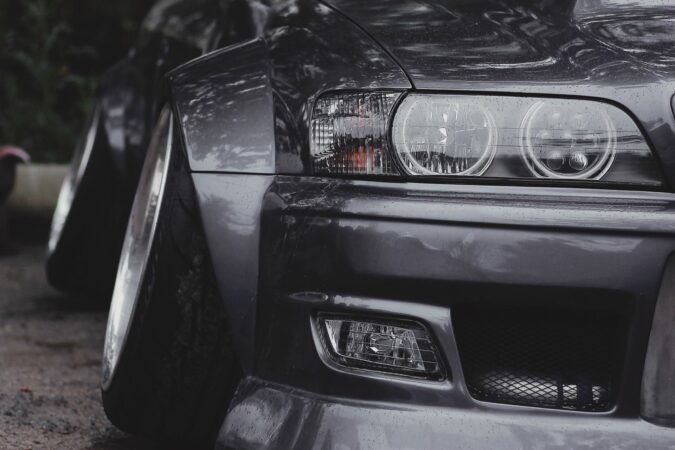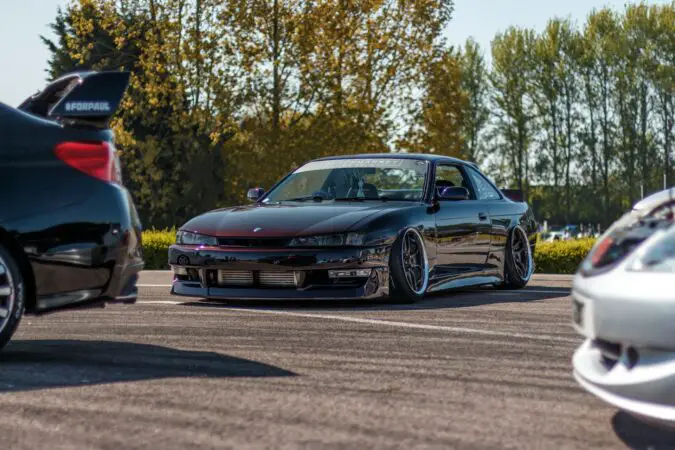Are you trying to learn what are tilted wheels on cars and you are looking to find out more about this mod? Well, if that is the case, then you came to the right place because this article will be all about tilted wheels on cars.
- What Is Camber?
- Camber Types
- Why Is It Important?
- Tilted Wheels
- What Are The Dangers?
- How To Tilt Them?
- Conclusion
- FAQs
Doing good research when it comes to these types of mods is always a good thing. Especially when it comes to tilted wheels which are also known as cambered wheels. Doing research will help you learn more about the positive and negative sides of running this mod on your car. And help you make the right decision.
We are saying this because stancing the wheels and increasing the camber can be rather dangerous for you as a driver, as well as for the passengers of your car. Since your car would not handle the best it can and you could face some really annoying situations that can be really costly.
So, this is why in this article we are going to elaborate on all you need to know when it comes to this type of mod. First, we are going to learn what is camber and the types of camber, and their effects on the car. Then we will cover what are tilted wheels on cars and the dangers of driving a car with tilted wheels.
After that, we will discuss wheel alignment and learn more about how to align wheels properly. So, if you want to learn more about this problem, follow along.
What Is Camber
Now before we cover what are tilted wheels on cars, let’s take a look at what is camber. We need to learn more about wheel alignment first before we dive into more complex topics. Namely, because people are struggling with similar issues and are not quite familiar with the problem. So, let’s elaborate more in detail.
What you need to understand first when it comes to wheel alignment is the types of angles that are important when it comes to the proper wheel alignment (and why bad wheel alignment is consequential).
The first angle is the caster angle. This is the mounting of the strut angle. This angle goes from the center of the wheel to the strut tower. This angle cannot be really manipulated and on most cars, with stock suspension, the caster angle is fixed all the time unless you install caster adjustment plates that will allow you to move the top of the strut. This includes both positive caster, as well as negative caster.
The next important angle that you need to be aware of is the toe angle. So, what is toe? Well, this is the type of angle that refers to where the wheels on your car are pointing at.
If the wheel is pointing on the inside, this means that there is a toe-in angle. Or if they are pointing on the outside, there is a toe-out. A good toe is usually somewhere close to zero.
The last and most important type of angle for us is your car camber angle. So, what is camber angle? Well, the camber angle is the angle between the vertical axis of the wheel and the vertical axis of the vehicle when you view it from the front or from the rear.
Camber Types
Now let’s take a look at the different types of camber and their effects on how the car drives. There are two types of camber that you should know.
And that is the positive camber and negative camber. Both of these types of camber have different characteristics looks-wise and also performance-wise. The ideal camber is close to negative.
So, this means neither positive nor too much negative. Now let’s move on and discuss the effects of positive camber and negative camber before we cover the tilted wheels on cars.
Positive Camber
Now let’s take a look at the positive camber effects before we cover the tilted wheels on cars. So, what is this positive camber?
Positive camber is the situation where the bottom of the wheel is pointing inwards. While the top of the wheel is pointing outward.
This situation will not be quite noticeable when the car is on the ground. Only when you lift the car the positive camber would be quite obvious. But even though this will not be visible. There will be some effects that this positive camber will create while you drive the car.
The main effect of positive camber is the increase in stability. The car would be a lot more stable in a straight line.
This is why this type of camber is often used on drag cars and other applications where there is a need for stability. Such as agricultural equipment and other heavy machinery that requires this type of suspension in order to function correctly.
Also, the positive camber was something rather normal when it comes to suspension adjustment on older vehicles.
For example classic cars from the 50s, 60s, 70s, and 80s. They all had a little positive camber because cars these days were like boats. Big and bulky with skinny tires.
So, a little positive camber adjustment was needed in order for you to be able to drive the car like this without worrying about ending on the side of the road. These cars didn’t handle corners particularly well.
But they managed to go in the straight like effectively. But what about tilted wheels on cars? We will get to that in a bit. Now let’s take a look at the negative camber effects.
Negative Camber
So, we covered the positive camber effects and we learned that the positive camber will improve your straight-line speed. Now before we dive into the tilted wheels on cars, let’s take a look at the negative camber effects on your car. What effects does negative camber create?
First, let’s take a look at what negative camber is in general. As we noted previously, positive camber is when the bottom of the wheel that is touching the ground is pointing inward and the top that is close to the fender is pointing outwards.
When it comes to negative camber, it is completely the opposite. In this case, the bottom portion of the wheel is pointing outward while the top portion of the wheel is pointing inward.
So, this type of angle gives you the complete opposite effect. When it comes to negative camber, there is low stability in a straight line at higher speeds. Especially when the angle is extreme like in our case with the tilted wheels on cars.
But this negative camber has a good effect when it comes to the cornering ability of your vehicle. Your car will take the corners a lot easier compared to the case when you have positive camber.
This is why we would recommend tweaking the camber if you plan to race your car. Your car would be a lot more stable on the track with the negative camber. Especially at high-speed corners.
This is why negative camber is the way to go for this application. Another thing to note is that the negative camber is also good in terms of grip. The car with negative camber will love to grip more in tight corners compared to positive camber.
Why Camber Angle Is Important
Now before we dive into what are tilted wheels on cars, let’s take a look at why camber angle is so important. We need to further elaborate on this topic and find out more about the importance of this type of angle.
Camber angle is really important if you want to get your car to drive well. If one of the wheels has positive camber and the other has negative camber, you will have a big problem.
And this problem will result in poor driving characteristics of the car. The car would not like this and will handle it pretty badly. The wheel could pull on one side and there could be a lot of vibrations that will come from the steering wheel into the cabin.
The latter is what might explain how your steering wheel shakes at low speeds, or how the steering wheel shakes when you’re braking downhill.
And on top of that, you will have uneven tread wear. So, what is uneven tread wear? Well, this is the situation when your tires do not wear evenly.
One tire could wear on the inside (in case you’re still wondering what causes tire wear on the inside) if you have negative camber or will notice that the outside of your front tires are wearing if you have positive camber. The former is also more commonly known as inner tire wear, or inside tire wear.
And this uneven wear can result in a greater chance of having a puncture. The tires that wear unevenly have a great chance of getting a puncture and you end up having a big issue and end up stranded in the middle of the road.
And this is something that you definitely want to avoid. Since it is very expensive to call a tow truck and also very expensive to change the tires (unless you learn how to change a tire on a car). This is why your wheel alignment should be your priority. So, be sure to look up tire alignment near me, and prep for a modest wheel alignment cost.
What Are Tilted Wheels On Cars
But what if you want to have negative camber on purpose and run this mod? Well, let’s cover more about that in the following chapter and learn more about what are tilted wheels on cars.
Now let’s take a look at what are tilted wheels on cars since not all people understand it. And if you were following us, after reading this chapter you will have an epiphany.
Tilted wheel is a term that is used to refer to negative camber. And by negative camber, we mean extreme negative camber. Not a camber that is only a few degrees on the negative side.
These cars are also known as stanced cars and there are basically whole communities that are focusing on these types of mods.
This type of car modification originates from Japan. And usually, stanced cars are often JDM models like the Miata, Subaru BRZ, Supra, and other famous Japanese models.
But why do people do this? Well, mostly to show off with their stanced car. But the ones that invented the stance culture were the Japanese drifters and outlaw street racing groups like the Bosozuku.
The drifters were doing this to gain performance and make their car drift better. And in so doing, it makes learning how to drift a car a bit easier. While the Bosozuku guys were doing this to show off.
And this car culture, just like many others, has found its way into the US. And here there are a lot of car guys that are avid JDM fanboys and try to follow every trend possible. It’s also a popular mod for those tuning up their cheap JDM cars.
There are also websites like stancenation.com that cover events and sell merch that is associated with this type of car modification. And when you see their fanbase, you will notice that it is pretty large, with 4 million followers on Instagram.
But cannot everything be positive when it comes to tilted wheels on cars and using extreme camber? What are the downsides of using tilted wheels on cars? Let’s elaborate more on that next.
Dangers Of Driving With Tilted Wheels On Cars
Now let’s take a look at the dangers of driving with tilted wheels on cars. We learned that tilted wheels are basically wheels with too much negative camber.
And driving like this with too much negative camber will have a big effect on the driving characteristics of the car. Remember that by doing this, most of the positive characteristics of negative camber will turn into negative ones. That’s why let’s elaborate on how this type of camber will affect your car.
Tilted Wheels On Cars, Hidden Dangers #1: Tire Wear
So, we learned what are tilted wheels on cars, now let’s take a look at what are the dangers of running these types of wheels on your car.
The first downside of running this type of wheel is tire wear. Uneven tread wear is often one of the downsides of positive and negative camber.
Usually, when you have positive camber tires wear on the outside. And when you have too much negative camber, tires will wear on the inside.
This wear on title wheels on cars will be quite exponential because these tires are basically running on the tire sidewall and not on the actual treads in extreme cases of negative camber that people want to run. Thus, you’re much more likely to cause tire sidewall damage.
And this would cause the tire to wear out after a few thousand miles. And this is really extreme wear. Also, quite expensive because you will go through sets of tires really quickly. Now let’s move on to the next downside of running tilted wheels on tires.
Tilted Wheels On Cars, Hidden Dangers #2: Suspension Wear
The next downside of running tilted wheels on cars is the suspension wear. So, why is this the case?
Well, this is the case because your suspension will be exposed to a lot of stress with this extremely negative camber angle.
Especially the CV joint (hence a broken CV joint or noticing CV joint noise) on the CV shaft can take a toll and fail too quickly. The bearings will wear out too fast and you will have problems with the suspension.
Other components that might take a toll with this type of modification are the shocks at the rear and the struts at the front end.
All these components are relatively inexpensive and can be purchased for a low price. Yet, more severe suspension repair costs can be fairly pricey. But still, they can take a big toll that could affect your driving and also your safety. Now let’s move on to the next downside of running tilted wheels on cars.
Tilted Wheels On Cars, Hidden Dangers #3: Difficulty Steering
The next downside of running tilted wheels on cars is the difficulty when it comes to steering. A car with a few degrees of negative camber would steer a lot better.
But if you go full-blown on negative camber, the car would steer rather poorly. It will like to slide a lot. So, you understand why drifters in Japan were using so much negative camber.
There is low surface contact of the wheel and the car slides a lot easier compared to when the rubber sticks to the ground completely.
So, with very little horsepower, you can lose the rear end and start drifting. But this would affect the steering a lot. You will not have the ability to steer the car as you previously did when you did not have tilted wheels on cars installed.
Tilted Wheels On Cars, Hidden Dangers #4: Difficulty Cornering
The next downside of running tilted wheels on cars is the difficulty cornering. The car would corner pretty badly with this type of wheel setup.
In the previous chapter, we explained why is this the case. The car would simply like to slide when you apply too much throttle and you would easily lose the rear end.
And if you do this on a corner is rather big if you don’t know what you are doing and this could lead to fatal injuries in some cases. This is why we would not recommend this mod to anyone that is not familiar with drifting and does not know how to drift.
And if you’re keen on learning how drifting works, we have guides on whether can you drift with FWD (front-wheel drive), and can you drift in an automatic car. Now let’s move on to the last downside of running tilted wheels on cars.
Tilted Wheels On Cars, Hidden Dangers #5: Poor Braking Ability
And the last downside of running tilted wheels on cars is the poor braking ability. The car would brake quite poorly when you are running this kind of setup.
This would be the case because there is not enough meat from the tire that touches the tarmac. So, the ABS (anti-lock brakes) system could go crazy and activate quite often. Especially under heavy braking.
The car could also slide when braking and you could end up rear-ending someone if you do this kind of setup.
So, that’s why we would not recommend it to anyone that wants to drive a car daily like this. By doing this, you not only risking the car but also your life as well. So, you get the idea why this is dangerous.
How To Adjust The Camber Angle
But I want to have tilted wheels on cars, how can I modify the camber angle on my car? Let’s elaborate more in detail about this in this chapter.
For this type of camber adjustment, you need to purchase special bolts that are known as camber bolts.
These are basic components that you can install on the control arms and then readjust the camber angle on your car.
In the video above, CrisFix is explaining how this type of mod is done on a car. There are other ways to adjust the camber angle as well. But we think that this is the simplest and also the cheapest method that you can try to adjust the camber angle on your car.
Whether you want to make the camber close to zero, negative, or positive. Now let’s conclude this article on tilted wheels on cars.
Tilted Wheels On Cars: In Conclusion…
In this article, we have covered quite a bit when it comes to the topic of tilted wheels on cars. First, we learned what is camber and learned about this type of angle.
Then, we learned more about what are tilted wheels on cars and the dangers of driving with this type of setup with so much negative camber. Lastly, we learned how you can do the camber adjustment on your car.
Remember, don’t try this mod unless you have enough driving experience and you definitely know how to handle when a car starts to drift.
Frequently Asked Questions
Now let’s answer some frequently asked questions.
What Is Camber On A Car
Camber is the angle of the wheels. Depending if they are tilted inward or outside, you can have positive and negative camber, respectively. Both types of angles alter the driving characteristics of the car in different ways.
What Is Negative Camber
Negative camber is the situation when your wheels are tilted inwards. So, the bottom of the wheel sits on the outside when you look at the car from the front or from the rear. Negative camber helps the car when it comes to cornering.
What Is It Called When Wheels Are Tilted
This situation is called negative camber or stance as some car guys call it. The technical term is negative camber. This is basically the camber angle of the wheel which is pushed to the absolute maximum.
What Is Stance Car
A stanced car is a car that has negative camber. This negative camber can be quite significant. It can be so extreme that the wheel could simply roll on the sidewall. Which is something that we would not recommend because of safety reasons.
How To Stance Car
Stancing a car could be done if you purchase stance bolts. With these bolts, you can realign the A-arms on your suspension and achieve this type of result. There are other methods. But this is the most common way and cheapest way to do it.
What Causes Negative Camber
Negative camber is caused by bad suspension components or poor alignment. Or on purpose by altering the suspension components in order to achieve this result. Too much negative camber will increase the stance of the car.





